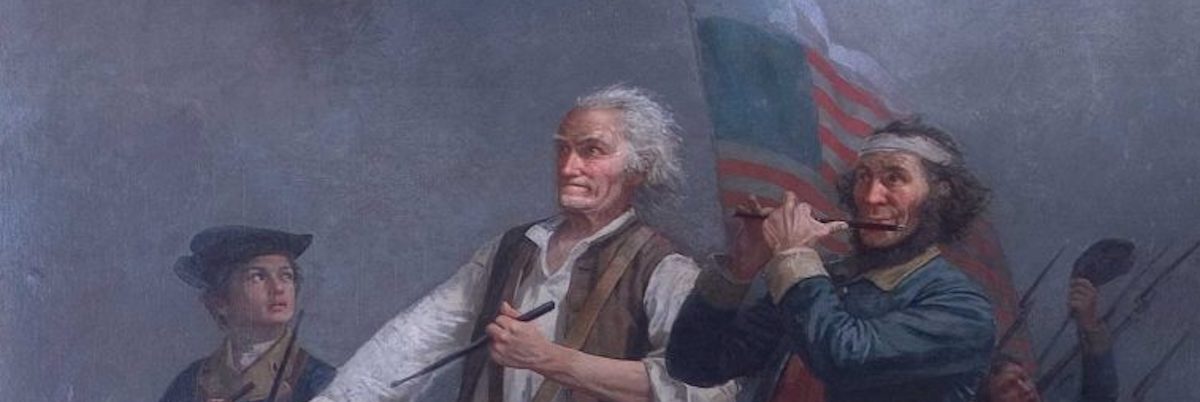This has been a question that I have been asking myself over and over for the past few years.
In another essay I have dealt with the differences of the Cloos/Crosby models vs the fifes made by Walter Crosby of Boston, (You can read that essay here Cloos-Crosby Fifes) but still wondered what caused Cloos to copy a fife from a maker in Boston?
Was it because Crosby fifes were so popular?
Yes, but it seems they were mainly popular in the Boston/New England area and not the entire country.
The answer, I believe, is with connecting some people and places together along a historic timeline.
Let’s first lay out a cast of characters and a short Bio on them:
NOTE: Before we start, this is NOT an essay on any of these people, it is just a timeline regarding the Cloos/Crosby model fife. Some of these folks I will address in other future essays.
Walter Crosby: Woodwind maker/turner in Boston. Crosby produced a fife which was marked W Crosby/Boston. The fifes made by Crosby mostly have tapered nickel silver seamed ferrules that are held on by a plug, they have a high point about a third of the way from the top, and they have different sized finger holes. Crosby spends his entire life in the Boston area.
William Bauer: Woodwind maker New York/Boston.
Henry Bauer: Woodwind maker Brooklyn, New York/Boston. Son of William Bauer.
Emil Bauer: Woodwind maker Brooklyn, New York/Boston. Son of William Bauer.
George Cloos: Woodwind maker Brooklyn, New York. Makes a fife model called the “Crosby” model fife. For more on the early timeline of Cloos’s business please refer to my essay: George Cloos Civil War Fifes.
William Cloos: Woodwind maker Brooklyn, New York/Boston. Son of George Cloos.
Oliver Ditson: Large music retailer Boston.
Charles Ditson: Large music retailer Boston/New York
John C Haynes: Large music retailer Boston/President of the Oliver Ditson Company.
Now that we have our cast of players, we can now start to piece together a timeline with places and events.
Mid 1800’s: Walter Crosby makes a fife that has tapered nickel silver seamed ferrules that has different size finger holes. The fife also has a profile in which the high point is about 1/3 from the top of the fife. Per my research, this might not be a new design, but might be a design Crosby copied from the person I believe he apprenticed with, William Callender. (There is evidence that Crosby might have apprenticed with William Callender. Crosby’s fifes are shaped very similar to Callender’s, and there is evidence that Callender was making fifes with different sized finger holes as early as the 1820’s. Subject for another essay.)

Before we head into the middle of the century, let’s set up a time line for Boston and a “business” connection between Walter Crosby and Oliver Ditson/John C Haynes:
1828: Walter Crosby goes into partnership with Henry Prentiss at 53 Court St, Boston.
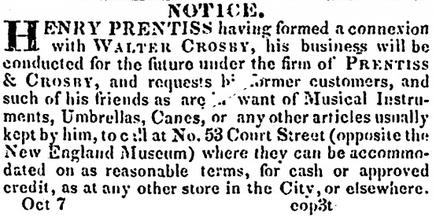
October 7, 1828 Boston Traveler
1830: The Crosby/Prentiss partnership is dissolved. Prentiss keeps the store at 53 Court St. (Paper says 52)
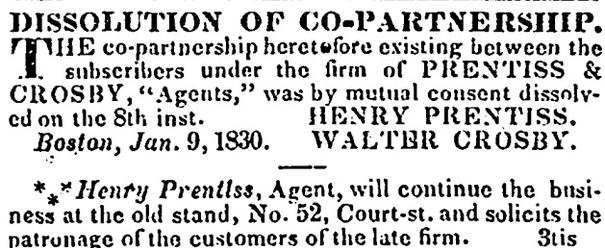
February 12, 1830 Boston Traveler
1839: Prentiss moves to 33 Court St, Boston.

March 19, 1839 Boston Traveler
1859: Henry Prentiss dies; Music Store is purchased by Elias Howe.

May 5, 1859 Boston Post
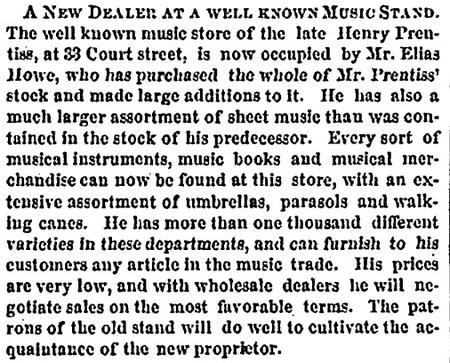
October 21, 1859 Boston Traveler
1861: The Music Store owned by Howe, formally Prentiss is now sold to Oliver Ditson and renamed for the junior partner, John C Haynes.

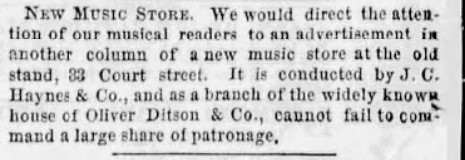
Thus in reality, Ditson has purchased the store which started out as a partnership between Crosby and Prentiss.
Ditson, being from Boston and engaged in the music business since 1823 would have known the connection between Crosby and Prentiss. Also, Crosby was an active musical instrument maker during this entire time, thus the 2 would have known each other.
Now let’s take a look at what is happening in Brooklyn NY with William Bauer and George Cloos.
1851: William Bauer arrives in the US. (NY Census of 1855)
1854: George Cloos arrives in NY. (See my essay on Cloos’s early years)
1855: William Bauer has 5 children, is listed as a flute maker, and seems to have at least 2 employees working for him. He has been in the country 4 years and owns property. (NY Census 1855)
1856: William Bauer flute maker, Lafayette St near Remsen. (Brooklyn Dir 1856)
1857 William Bauer musical instruments, Lafayette St near Remsen. (Brooklyn Dir 1857)
1860: William Bauer, who is listed as a flute maker, stands up for George Cloos and his brother. Bauer states that he has known Closs (Cloos) since he has been in the United States. There is a great possibilty that Closs (Cloos) apprenticed/worked with Bauer as we will see from the next listings.
Note, I will be referring to Closs as Cloos going forward. To understand the changing of the name please refer to my essay on Cloos.
1860: William Bauer and George Cloos live almost next to each other. (1860 Census)
1862: Bauer and Cloos have the same address location. Lafayette near Remsen. (Brooklyn Dir 1862)
1863: Cloos is listed at Lafayette/No Bauer is listed. (Brooklyn Dir 1863)
1864: Bauer and Cloos at same address, Lafayette. (Brooklyn Dir 1864)
1865 George Cloos states he started his business. (History of Kings County 1884)
1865: Bauer and Cloos at same address, Lafayette. (Brooklyn Dir 1865) On the Census of 1865 Cloos states that he does not own land.
1866: Bauer and Cloos at same address, Lafayette. (Brooklyn Dir 1866)
1867: Bauer at Lafayette, no listing for Cloos. (Brooklyn Dir 1867) An interesting event is that George Cloos’s brother is living at Stagg St, the future home of George Cloos Company. Oliver Ditson opens his New York Branch under the control of his son, Charles Ditson.
1868: No listing for Bauer or Cloos. (Brooklyn Dir 1868)
1869: No listing for Bauer/George Cloos is living with brother at the Stagg St address.
1870: Cloos living with brother at Stagg St. Brother owns property, George does not. (1870 Census)
From this timeline we can conclude the following:
Bauer owns property and is running a business making musical instruments (Flutes)
Cloos for most of the 1860’s is living near Bauer and also lists his vocation as a musical instrument maker.
There is a great probability that Cloos is working for, if not apprenticing with William Bauer as Bauer is the only woodwind musical instrument maker in the area during this time period.
As the 1860’s end, Cloos moves in with his brother, but does not own any property.
So with all this said, by the end of the 1860’s we have Cloos working for Bauer in New York and we have John C Haynes running a music store with roots to Walter Crosby up in Boston. We also have Oliver Ditson opening a branch in New York, run by his son, Charles Ditson.
Now let’s cover the period of the 1871-1880.
1871: Cloos is living at 29(39) Stagg St with his brother (Brooklyn Dir 1871) Bauer is not listed.
1872: Cloos and brother living at 39 Stagg St, Bauer at 6 La Grange. (Brooklyn Dir 1872)
1873: Bauer in Brooklyn. Directory is incomplete, so was not able to find Cloos. If another copy becomes available I will update this listing. (Brooklyn Dir 1873)
1874: WALTER CROSBY DIES.(In Boston) No Brooklyn Directory available at this time.
1875: Cloos is living next to his brother on Stagg St, owns no property. Bauer is living in Brooklyn. (1875 Census)
1876: William Bauer & Son (Henry Bauer) Musical Instruments 103 Court St Boston (Boston Dir 1876) and also still listed in Brooklyn. George is listed as Charles and is living with his brother. (Brooklyn Dir 1876) On Dec. 14th George’s brother, Gotthard Cloos dies and is buried in the Lutheran Cemetery, Brooklyn. Gotthard’s wife moves to Iowa. (Find a Grave) At this time George Cloos becomes the owner of 39 Stagg St., Brooklyn. Whether George has purchased the property from Gotthard’s widow, or has been given the property after Gotthard’s death is not known at this time.
1877: No directory for Brooklyn, Bauer is at 103 Court St, Boston. (Boston Dir 1877)
1878: Henry Bauer (William Bauer’s son, thus Bauer & Son) removed to N York. William Bauer at 103 Court St. (Boston Dir 1878) Bauer is still listed in Brooklyn. George Cloos is listed at 132 Leonard St with House at 39 Stagg. (Brooklyn Dir 1878)
1879: Bauer is listed at 103 Court St, Boston. (Boston Dir 1879) Cloos is at 132 Leonard St with House at 39 Stagg.
So, as the 1870’s come to a close we have William Bauer having moved from Brooklyn to Boston, first to be in business with his son Henry, who leaves in 1878, then to be in business by himself, and we have George Cloos taking over the house in which his brother owned, after said brother’s death.
Now begins the 1880’s in which I will combine what all our parties are doing both in Boston and in Brooklyn.
1880: William Bauer 103 Court St Boston/Email Bauer 109 Court St. (Boston Dir 1880) Emil starts work for Ditson/Haynes. (The Musical Record 1896) Cloos at 39 Stagg St Brooklyn. (Brooklyn Dir 1880)

The Musical Record 1896
1881: William Bauer 271 Ruggles (Boston Dir 1881) No Brooklyn directory at this time.
1882: John C Haynes starts selling Clarinets made by George Cloos. (Musical Record and Review April 1882), William Bauer at 271 Ruggles Boston. (Boston Dir 1882) Bauer dies April 21, 1882 age 61.
William Bauer’s death certificate states that he died of Bright’s Disease and also states that he had it for 4 months. That would have put him out of commission toward the end of 1881. Bauer is buried in the Forest Lawn Cemetery in Boston.

Musical Record and Review, 1882
1883: Anna Bauer, widow, at 271 Ruggles Boston. (Boston Dir 1883) Cloos at 39 Stagg St Brooklyn. Runs ad in the Brooklyn Directory for the first time advertising his business. (Brooklyn Dir 1883)
Also in 1883 John Haynes advertises in his catalog of 1883/1884 that he is now the agent for George Cloos fifes, piccolos, flutes and clarinets. At the same time Haynes starts to offer the “Crosby” model fifes, which BTW look very much like a Cloos/Crosby model instrument.

Brooklyn Directory 1883

Haynes Catalog for 1883/84

Haynes Catalog 1883/84
1884: Cloos states that he started his business in 1865 and now has 10 employees and sells $10,000 worth of musical instruments. (History of Kings County 1884). J C Haynes starts advertising “Crosby Model” fifes. (Boston)

Boston Journal May 22 1884
1885: William Cloos (Son of George Cloos) takes over the old address of William Bauer in Boston. (Leading Manufactures and Merchants of the City of Boston, 1885)

Leading Manufactures and Merchants of the City of Boston, 1885
1886: George Cloos at 39 Stagg St Brooklyn. (Brooklyn Dir 1886)
1887: William Cloos back in Brooklyn. (Brooklyn Dir 1887) John C Haynes is advertising “Crosby Fifes”.

Boston Herald November 13, 1887
1888: George Cloos 39 Stagg St Brooklyn (Brooklyn Dir 1888) John C Haynes is advertising “Genuine Crosby Fifes”.

Boston Herald October 14, 1888
1889: George Cloos 39 Stagg St. (Brooklyn Dir 1889)
Thus ended the 1880’s, now it’s time to put the pieces together!
Now that we have laid out a historic timeline and put the players in place and have a look at some facts:
1861: Oliver Ditson purchases a store with the roots to Walter Crosby. The store is named for the junior partner at that time, John C Haynes.
1867: Charles Ditson (son of Oliver) opens a branch of Ditson in New York City.
During 1860’s and the 70’s Ditson starts an expansion of his business in many areas of the county by opening John Church (Cincinnati) in 1860, Lyon & Healy (Chicago) in 1864, Chas Ditson (New York) in 1867 and J E Ditson (Philadelphia) in 1875, thus giving Ditson connection in major cities in the north and central part of the United States. At this time Ditson was also on a major buying spree, buying companies as Firth & Son (New York) in 1867, William Hall (New York) in 1875, etc…The purchase of these other firms was done not for the making of musical instruments, but for obtaining the rights to these firms published music. Ditson was a very large publisher during this time and basically was trying to corner the market on music. When Ditson would buy a firm, such as William Hall, they would not have been interested in the musical instrument making part of the trade, it was strictly for the music catalog that they processed. But as the 1860’s moved toward the 1870’s, and Bands in the United States started to grow, the Ditson firm started to see more and more sales through its’ musical instrument division, John C Haynes.
John C Haynes started out as strictly a musical instrument retailer for the Boston area, but as the Band movement started to grow in the United States, Haynes started to branch out. By the 1870’s they were becoming, what we call in the industry, a jobber.
A jobber in the music industry is one that might purchase large quantities of an item from a manufacturer and sell them to other dealers. A jobber might import, or have manufactured a product under their own name and distribute this to other dealers.
Thus was the case with John C Haynes. As they entered the 1870’s they started more and more selling to the trade and distributing items. Thus at that time they started to import and have items (musical instruments, etc…) produced with their own name, as well as some of the trade names they had created, i.e. Henry Gunckel, Bay State, etc….
An example of this is the following 3 fifes:
Oliver Ditson
William Pond
All three are stamped different, Oliver Ditson, John C Haynes, William Pond, yet all were made by the same maker. (Not any of the fore mentioned.)
Ditson /Haynes would have always been looking for makers to produce products for them, and this is where I believe William Bauer originally came in.
As stated before, in 1867 Diston, through his son Charles, opens a branch in New York City. Being in the music business, Charles would have become acquainted with all others being in the business in the New York area. Charles most likely helped connect William Bauer up with the main branch of the Ditson Company, and the connection finally prompted Bauer to move to Boston to be closer to the main Ditson store. It was during this time that Bauer’s son, Emil, was offered a job at the Haynes Company, thus cementing the relationship of Ditson/Haynes and Bauer. Unfortunately, within a year or so after Emil starts working for Haynes, William Bauer takes sick and finally dies, thus leaving Ditson/Haynes without a local source for production of woodwind instruments.
Thus enters George Cloos.
George Cloos has been in Brooklyn NY since the mid 1850’s and most likely apprenticed with/worked for William Bauer up until approximately 1865 when he is said to have started his own business. When Bauer left in the late 1870s, it is possible that Cloos took over whatever manufacturing Bauer did for the local businesses in New York, and might have helped Bauer fill any of the back log of orders that would have started coming from Diston/Hanyes.
When Bauer took sick in the later part of 1881, more and more work could have been shifted to the Cloos workshop in Brooklyn, and Cloos would have become one of the main OEM suppliers for some of the Ditson/Haynes flutes and fifes. It is in 1882 that we first see Haynes advertising the Cloos Clarinets and in the catalog of 1883 Haynes states that they had just “secured the agency” for the Cloos line of instruments. Also in this same catalog Haynes is now selling a “Crosby Model” fife, which looks very much like a Cloos Crosby Model.
In 1885 George Cloos sent his son to open a shop in Boston (Very much like Bauer did with his son earlier) at the very same location that Bauer was at, thus keeping a maker close to the main Ditson/Haynes stores yet having most of the larger manufacturing done back in Brooklyn where in 1884 George Cloos states that he has a workforce of 10 and is selling $10,000 a year. $10,000 in 1884 is the equivalent to $337,000 dollars in 2016. (Toms’ Inflation Calculator) With a company large as Ditson/Haynes it would have been very easy for Cloos to achieve this level of business.
In 1887 William Cloos is back in Brooklyn working for his father, thus it must have been decided that there was no need for a branch office of the Cloos Factory close to the Ditson/Haynes stores.
It also could have been because Haynes was starting to get more and more into instrument manufacturing at this time thus they were hiring inside people to do some of the work that William Cloos was doing for them. That didn’t mean they didn’t need George Cloos still to produce different products for them, it just meant that they needed more quantity of the product.
Also occurring in the 1880’s was the resurgence of the Grand Army of the Republic, in which the history can be obtained on the GAR Wikipedia page:GAR History. With the resurgence of the GAR many fife and drum groups were organized across the country, thus the need for need for fifes became more and more as the 80’s wore on. This would account for Haynes starting to advertise drums and fifes more prominently in the newspapers and catalogs, and with Haynes being in Boston, many of their customers from the war would have remembered their townsman, Walter Crosby.
Walter Crosby made an upscale fife that was popular in the New England area during the Civil War. (You can read a little regarding the Crosby fifes in my essay on Cloos-Crosby.) Ditson/Haynes would have known Crosby and it would have made sense to capitalize on the name. It is not known at this time whether Haynes contracted with Bauer to produce a fife with the “Crosby” name, but it is certain that the “Genuine Crosby Fifes” were being made during the time when George Cloos made an appearance with the Haynes firm. All one has to do is look at the 1883/84 catalog and see that the fife that is pictured is very much a Cloos-Crosby model. (Whether Cloos is marking the fifes just “Crosby” or “Crosby GC” is not known at this time.) It is interesting to note that the cost of the Crosby Model fife is over 10 times the cost of a regular fife made of the same wood with the same German silver ferrules. This shows that they are playing on Walter Crosby’s reputation as a superior craftsman.
By the 1890’s the Haynes firm was getting more and more into the producing of their own flutes, thus their business with Cloos get less and less except for the producing of cheap flutes and fifes. By the middle/ late 90’s Cloos is selling and producing for other firms such as Sear and Roebuck and Carl Fischer.
Now with all that said, the question still is:
When did the Cloos Crosby model fife come into existence?
Well from the facts we know this:
1874: Walter Crosby dies.
1875: William Bauer steps up shop in Boston. Bauer is listed in the 1876 edition of the Boston Directory, thus it is reasonable to state that he was in Boston in 1875 working/setting up shop.
1883: Haynes becomes an agent of the George Cloos Company and is now advertising “Crosby Model” fifes in their catalog.
With this evidence, it stands to reason that we can say the first appearance of the Cloos/Crosby model fifes happened about this time.
Thus I would dare to say that the Cloos /Crosby model made an appearance circa 1882, but I do not think the first models were the same as most of the Cloos/Crosby fifes selling on the market today, and this is because of 2 features: Finger holes and seamed ferrules.
In my collection is a fife with no maker’s mark but was presented to Fife Major John Connard by the 9th Regiment Drum and Fife Corps of New York. Feb. 22. 1883.

Connard Fife 1883
This fife is a copy of a Crosby fife, but not an exact copy. The basic profile of the fife is very much like a Crosby with the high point being about a 3rd from the top. The finger pattern is very much like a Crosby in regards to the size of the holes, and it has long ferrules, but this is where the similarities stop.

Connard Fife Finger Holes

Connard Presentation

Connard Ferrule
I compared the instrument to another one in my collection made by Cloos (Crosby GC Fife) that was a Crosby Model.
Here is what I found:
The high point is in almost the same point on both.
The bore was exact on both of the fifes: .435
The size of the ferrules were exact, 1.98 inch.
The taper of the ferrules were very, very close: .61-.69/Connard, .62-.69/Cloos.
Both instruments had no punch marks to keep the ferrules attached, thus there was a glue type substance used.
The interesting discovery was that the Connard fife had seamed brass ferrules that were silver plated where the Cloos had seamless nickel ferrules.

Cloos and Connard Ferrules
My conclusion after examining both is that the Connard fife was made by George Cloos, and as of 1883 Cloos was using seamed ferrules and the Crosby finger pattern. (You can see more on the Crosby finger pattern on my essay on Cloos Crosby)
Another interesting observation is that the Connard fife and an original Crosby fife are the same pitch and hole spacing.
Here is a picture of the Connard fife with one of the original Crosby fifes that is in my collection.

Crosby Fife (Top) Connard Fife (bottom)
As you can see, the embouchure hole as well as the finger holes line up and it is obvious that the Connard fife was made by coping a Crosby fife.
Again, with what was stated before, it seems that the Crosby model fife made by George Cloos started to make an appearance around 1882/1883, but not in the same form that later Cloos/Crosby’s became as Cloos changed his hole pattern, at least on the Bb fifes, to a different pattern then what Crosby used.
Now with all this said one thing still bothered me regarding the use of the Crosby name. Why would John C Haynes use a man’s name that was so known in Boston and right under the nose of Walter Crosby’s widow, who was still live during this period? Wouldn’t this open the firm of Ditson/Hayne up to lawsuits?
Maybe, maybe not.
Mary Crosby, widow of Walter Crosby, out lived him by 17 years, dying in 1891. In Mary’s will she leaves an estate that is large enough to basically put money in trust for her granddaughter. Yes, when Walter Crosby died he was worth a large sum, but I wondered if the widow might also have had a connection with Ditson/Haynes.
Now I must state that I am not 100 percent sure that there was some type of agreement, but the connection I believe comes from John C Hayne’s daughter Cora, who married…….Isaac Crosby!
The relationship of Walter Crosby to Isaac is not known at this time, but it might account for the connection.
SHORT VERSION:
1. Walter Crosby makes a fife that becomes popular in the New England States and dies in 1874.
2. John C Haynes is partners in a music store in Boston where he knows the value of selling on the Crosby name for fifes.
3. Charles Ditson finds a maker to help produce some of their OEM products which leads to George Cloos becoming that maker.
4. In the early 1880’s Cloos produces a “Crosby Model “ fife for the Haynes firm.
Moral of the story:
NO CLOOS/CROSBY MODEL FIFE IS EVER A CIVIL WAR ERA FIFE!!!!!!
